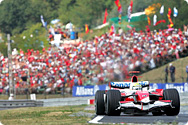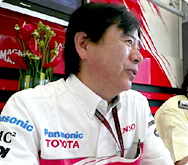Grand Prix > 2007 Grand Prix > Grand Prix of Hungary > Review
|
|
07 Aug,2007 (Tue)
Thank you again for your continued support. This weekend we visited the only F1 Grand Prix held in Eastern Europe, the Hungarian Grand Prix. The site of the race was the Hungaroring circuit, often described as "Monaco without guard rails." Without further ado, here is my report the events of the Hungarian Grand Prix.
Introducing new aero parts ahead of schedule; pit work issues completely ironed out
 Hungaroring is known for its slippery surface and strong understeer tendencies early in the race weekend. But practice progressed smoothly for Panasonic Toyota Racing on the first practice day, and the team was able to overcome all of the issues prior to qualifying.
Hungaroring is known for its slippery surface and strong understeer tendencies early in the race weekend. But practice progressed smoothly for Panasonic Toyota Racing on the first practice day, and the team was able to overcome all of the issues prior to qualifying.The Hungaroring is a narrow, twisting circuit, very similar to Monaco in its requirements for high downforce. As such, we basically brought our high downforce specification package adopted for the Monaco Grand Prix, but we also added some parts that performed well in recent wind tunnel testing. In particular, we introduced new shapes for the floor front and leading edges of the side pontoons. We also made some changes in the diffuser, although these wouldn't have been apparent to the casual observer. We created a new high downforce specification for the front wing, incorporating a mid-downforce spec end plate that showed strong performance characteristics. At the European GP two weeks ago, we experienced a few difficulties during pit stops. After the race, we analyzed video footage from cameras we had set up in the garage, and we were able to identify the underlying issues. We have since put new measures in place to hopefully prevent another occurrence of the same errors.
Day One: Trouble with Hungary’s famous graining and understeer
 For Hungary, Panasonic Toyota Racing brought new aero parts for the side pontoons, floor, diffuser, and front wing, built on the Monaco specification base.
For Hungary, Panasonic Toyota Racing brought new aero parts for the side pontoons, floor, diffuser, and front wing, built on the Monaco specification base.For the Hungarian GP, Bridgestone brought their supersoft and soft compounds, the softest of the four compound types they plan to supply during the year. Knowing this, we knew we would be in for some considerable tire graining (abrasive rubber wear) during the first day of the race weekend. As expected, the morning’s free practice showed graining for both of our drivers. All of the other teams had graining symptoms as well, and no one had been able to completely solve the issue even after the end of the afternoon practice. During the afternoon session, we tested both types of tires under long-run conditions, and then tried to change settings to improve the car's handling. But as of the end of Friday afternoon, we still hadn’t solved our understeer issues.
Still, since the Hungaroring doesn’t normally host races, the circuit was slippery, and conditions made for easy tire graining. On top of that, the other fact of this circuit is that teams tend to have to fight understeer. As the rubber grip builds up on the track surface, the graining problem tends to improve. Overall, we were able to complete our Friday program in good order without any major problems, so we used this data to plan our Saturday morning free practice setup.
New parts pay off? Jarno marks P3 during Qualifying Period 2
Using Friday’s data, we changed our settings going in to Saturday’s free practice. We saw quite a bit of improvement in the graining behavior of Jarno’s (Trulli) left front tire compared to the day before. On the other hand, Ralf (Schumacher) didn’t have as much problem with graining as Jarno did, but changes in camber we introduced made the graining problem worse. We decided to move Ralf’s settings back before the start of qualifying. As a result, both drivers were able to make fantastic attack laps during qualifying. In particular, Jarno recorded a lap in the 1m19s range during the second qualifying period, proving that the TF107 has definitely improved.
 Jarno scored a top 3 time during the second qualifying period. The next goal is to excel during the final period, when fuel loads are the same level as the start of the race.
Jarno scored a top 3 time during the second qualifying period. The next goal is to excel during the final period, when fuel loads are the same level as the start of the race.Both of our cars moved on to the third qualifying period, vying among the top 10 cars for the best spot on the starting grid. During the first two qualifying periods, cars run with a light fuel load from the start. During the third qualifying session, cars have to start with the same fuel load they will use at the start of the race. Unfortunately, our cars weren’t able to perform their best under a heavy fuel load. Ralf and Jarno ended up qualifying P6 and P9, respectively. Looking back on the results of qualifying, I think we could have made it a bit farther up the grid. Having said that, our new aerodynamic parts-barely arriving in time from the factory-definitely contributed to our boost in performance. We saw a chance for both of our cars to finish in the points.
Ralf’s brilliant performance, holding off the current world champion
After qualifying, a penalty was assessed to a competing team, so Ralf and Jarno both moved up one spot on the starting grid. While Ralf, now starting P5 on the driving line (clean side of the track), got off to a fairly good start, Jarno moved from an odd numbered grid spot to the even-numbered (dirty) side. Although his start was not terribly bad, during ensuing fight for position in the first corner, Jarno was forced into a difficult spot, losing position on the track. On a track as difficult to overtake as the Hungaroring, starting position and position immediately after the start of the race determine much of who will win and who will lose. I think Jarno’s race result was essentially decided after the first corner.
 The start is everything at a circuit with so few overtaking points. Ralf protected his grid position, scoring the team's highest finish so far this season at P6.
The start is everything at a circuit with so few overtaking points. Ralf protected his grid position, scoring the team's highest finish so far this season at P6.Meanwhile, Ralf was able to keep his position off the grid, but he wasn’t able to improve his pace as much as we had hoped. After the second pit stop, he lost position to Fernando Alonso, with whom Ralf had been running a tail-to-nose fight since the start of the race. As a team, we need to understand how we could have lost to BMW Sauber, when that team adopted a three-stop strategy as opposed to our two-stop strategy. Even so, Ralf drove a brilliant, tenacious race, fighting back the current champion Alonso all the way until the third stint.
Even though we showed good potential, we still have yet to leave a top result in the race. But the three points we won in Hungary were very big for Panasonic Toyota Racing, as they represented our first points during the second half of this season's European Round. As we take this momentum into the next race, we ask for your continued support behind our efforts to shoot for even better performance and better results. Thank you.

Noritoshi Arai at the Hungaroring. Finally showing its true colors, the team has shaken off the disappointment of previous races. The next goal is to have both cars finish in the points.